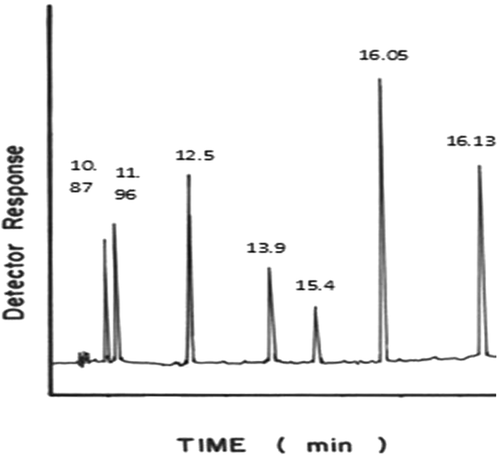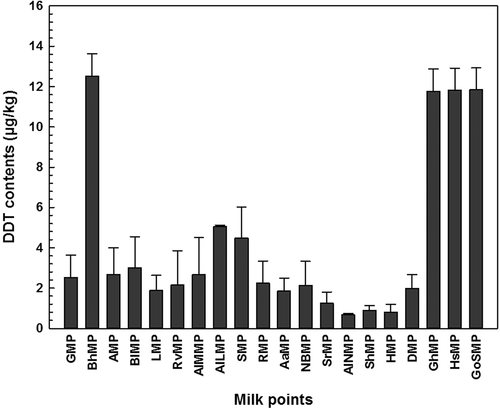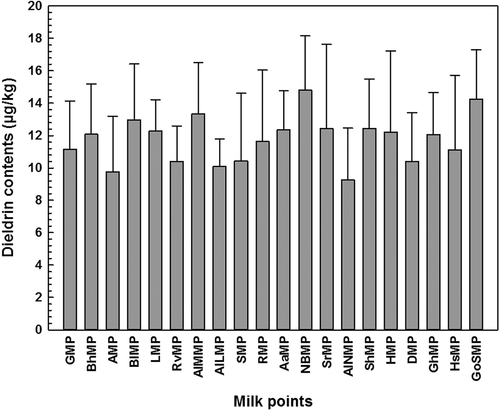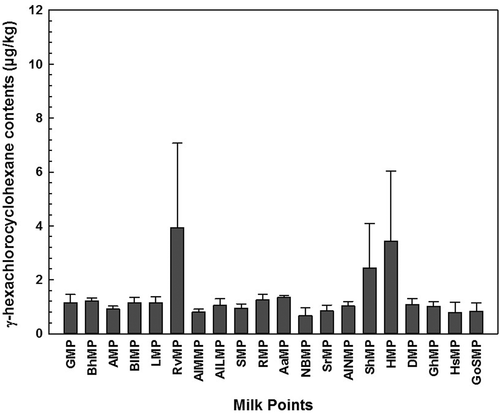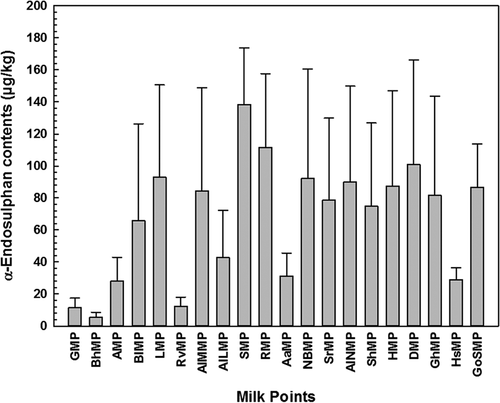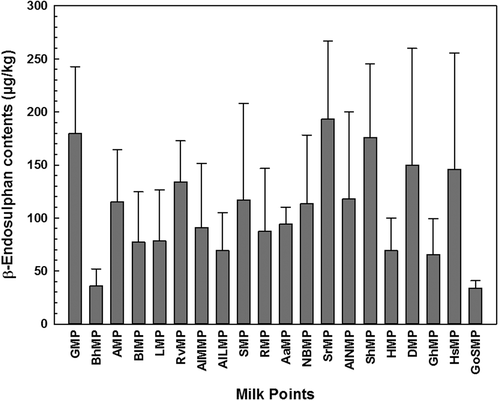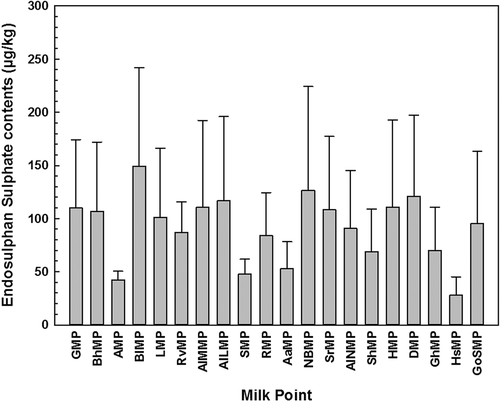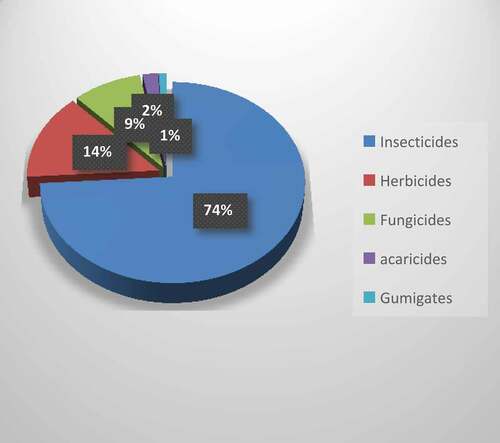ABSTRACT
Milk and milk products are considered to have tremendous nutritional values as they contain a good proportion of protein, fats, and important minerals. However, the nutritional value of the milk produced in Pakistan is not up to the mark as extensive use of pesticides on crops resulted in contamination of milk. Consumption of contaminated food such as milk, meat, fish, eggs can induce increased proportion of organochlorine pesticides in the body. The purpose of this study is to determine organochlorine pesticide residues in milk and their toxicity level by Maximum Residues Level (MRL) values. In the current study, organochlorines such as Dichlorodiphenyltrichloroethane (DDT), Dichlorodiphenyldichloroethane (DDE), Dieldrin, Gamma-hexachlorocyclohexane (Ɣ-HCH) also known as Lindane, α-Endosulphan, β-Endosulphan and Endosulphan sulphate were detected with the help of gas chromatograph equipped with electron detector. These pesticides were confirmed by using gas chromatography-mass spectrometry (GC-MS). Analysis of variance is applied (ANOVA) to determine variations of pesticides in all milk samples. Analysis showed non-significant results (p > 0.05) with large variation among all milk samples regarding pesticide residues. The mean values of DDT, DDE were found to be below the MRL value. The mean values of Dieldrin, Ɣ-HCH were also below MRL value. On the other hand mean values of α-Endosulphan, β-Endosulphan, and Endosulphan sulphate were slightly higher than MRL in few milk points. The present study showed large variations of pesticides residues present in milk samples.
Introduction
Milk is considered as a complete food because of its extraordinary nutritional value. Milk production in Pakistan is approximately 42.17 million tons. Throughout the world, Pakistan is included in top milk-producing animals ranking at fourth position. In Pakistan, milk is produced by the cow, buffalo, sheep, goat, and camel but being a major contributor, cattle, and buffalo is considered to be the elite milk-producing animals.[Citation1] Cattles constitute 53% of total milk-producing animals in Pakistan and add 35% of the gross milk production of Pakistan. Rural areas are the highest milk producing areas by achieving 80% milk production along with peri-urban areas that contribute 15% milk as well as 5% milk is produced by urban areas.[Citation2]
It has been few years where many researchers are claiming the existence of pesticide residues in milk. Improper treatment and extensive use of pesticides have resulted in threats to human health and economic loss. Adoption of pesticides can be measured by the presence of pesticides left in an environment.[Citation3] One of the necessary and unavoidable components of modern agriculture is increased crop production to meet the demand of growing populace.[Citation4–Citation7]
During last three to four decades, there has been increased use and development of pesticides. Currently, new ways have been introduced for production and protection of crops, moreover, for the preservation of food products such as grain storage in warehouses.[Citation7] A different environment like soil, water, air is contaminated with pesticides including organic and inorganic pollutants.[Citation8–Citation12] All factors including biological, physiological, and chemical processes, that is, biochemical degradation, leaching, moisture contents, microbial activity, and all organic contents determine the behavior of pesticides in relation to the soil.[Citation13–Citation15]
In Pakistan, farmers use 39 types of herbicides, 108 type of insecticides, 30 types of fungicides for the betterment of crop.[Citation16] Mostly, organochlorine, organophosphorus, phenoxyacetic acid herbicides, carbamate, pyridinium herbicides, triazine herbicides and substitute urea are commonly used by farmer community.[Citation16] Organochlorine residues have been recorded by many researchers in the soil of Pakistan due to persistent nature of these pesticides.
Organochlorine pesticide residues can enter into the food chain slow degradation of organochlorine in an environment.[Citation17–Citation21] Organochlorine pesticide residues contaminate food like meat, milk, and fish. Consumption of this kind of contaminated food cause exalted level of pesticide residues in the body.[Citation22] These pesticide residues accumulate in an animal body by using contaminated feed, grass, corn silage and water. Many studies have been done on the associated organochlorine pesticide residues in water, soil and food chain.[Citation23–Citation27] Organochlorine and organophosphorus pesticides have been widely used. Pesticides residues get incorporated into the soil particles resulting in contamination of soil after application, drainage, and disposing of these pesticides. Organochlorine is not synthesized in Pakistan. Therefore, these pesticides are imported to meet the demand for pesticides.[Citation28]
Milk is considered good at dissolving fat-soluble pesticides like organochlorine pesticides.[Citation29] Literature shows that human health is affected by consuming contaminated food with organochlorine pesticides.[Citation30] One of the studies also indicated the presence of DDT and HCH in milk and also the level of DDT is higher than HCH. It also pointed out the presence of organochlorine pesticide residues in dairy products.[Citation27] Additionally, a few studies have probed about feed and water contamination with these pesticides. Feeding milk-producing animals on these contaminated feed is one of the reasons for the existence of organochlorine pesticides in milk.[Citation28] The study aimed to determine the toxicity level of organochlorine in milk as compared to the suggested MRL value.
Research methodology
Collection of milk samples
Milk samples (250 mL) are collected from local markets of Sahiwal. These samples are collected in sterilized glass bottles which were airtight. The fresh sample so collected placed in cool boxes which consist of ice packets.
Sample extraction
The extraction of the sample was based on Kampire et al.[Citation27]The milk sample was defrosted, regimented and mixed thoroughly. Then 100 mL sample was taken and divided into two equal parts. Then 1 g of fat was taken and was mixed anhydrous sodium sulphate in a 250 mL flask. After the mixture got set, then petroleum ether was filtered to in another tube containing anhydrous sodium sulphate through glass funnel. This concentrated material added in 3 mL of hexane to clean out.
Cleanup with the florisil method
Glass column of 15 cm long plugged with glass wool and washed with hexane. The concentrated fat extract was added to this column, and then it was eluted to 100 mL n-hexane to extract organochlorine pesticide residues. The resultant material was added to 250 mL round bottom flask and mixed with anhydrous sodium sulphate. The residue was dissolved in 1 mL cyclohexane for GC analysis.
Gas chromatography
Gas chromatography (GC) was based on Kampire et al.[Citation27] For GC analysis, a variant gas chromatograph (Hewlett Packard 5890 series 11) equipped with Ni63 Electron Capture Detector (ECD) fitted with semi-polar and non-polar fused silica capillary column (Integrator HP 3396:A) along with 30 m length and 0.25 mm ID (internal diameter) along with 0.25 µm film thickness was used. Hydrogen gas (Purity ~ 99.9%) with a controlled rate of 1.2 mL/min was used as carrier gas at the rate of 30 mL/min as auxiliary gas with ECD. Nitrogen gas was used as electron capture detector (Purity ~ 99%). The injector temperature was 250°C; detector temperature was kept 300°C. The initial column temperature was 110°C kept for 1 min then raised at a rate of 20°C/min to 165°C kept for half a minute and again raised at a rate of 2°C/min to 235°C and maintained for 1 min, and finally raised at a rate of 35°C min−1 to 280°C where it was maintained for 4 min. The injection volume was kept up to 1 µ/L.
Calibration of the GC was achieved before the sample analysis using the standard pesticide obtained from Engro Corporation, Pakistan. The detection of limit (LOD) was ranged from 0.01, and 0.04 µg/kg milk fat and the limit of quantification (LOQ) was 0.01 µg/kg for DDT, Ɣ-HCH, Endosulphan and 0.03 µg/kg for Dieldrin and DDE.
Determination of recoveries for each milk sample was carried out by spiking the fresh milk samples with a particular concentration of pesticides (known concentration). 1 g of milk fat was spiked with 1 mg/mL of a standard solution of pesticides in blank samples and produced further spiking samples ranging 0.04 µg/kg and 1.0 µg/kg from standard solution.
Chromatogram of organochlorine pesticides analyzed by GC-ECD
Retention time for DDT, DDE, Dieldrin, Ɣ-HCH, α-Endosulphan, β-Endosulphan and Endosulphan sulphate is 16.05 min, 15.4 min, 16.13 min, 10.87 min, 11.96 min, 12.5 min and 13.9 min. Detector temperature was set to 300°C, and the injection volume kept up to 1 µ/L ().
Statistical analysis
Analysis of variance (ANOVA) was executed by using Minitab-17 to analyze the data of pesticide residues to find out the variation in residues contents among all milk samples from different milk points.
Result
All milk samples were collected from Sahiwal region because Sahiwal is well known for milk production. Cotton is the most cultivated crop in this region along with crops like wheat, corn, etc. cattle are fed on agro-industrial by-products such as cotton, wheat, khel. This may transfer chemicals like pesticides to cattle and ultimately in milk.
Variation of OCPs among all milk points
A significant difference in the presence of organochlorine pesticide residues was not found among all milk samples. Nevertheless, large variation was found in all milk samples. Following are the results of each OCP, i.e., DDT, DDE, Ɣ-Hexachlorocyclohexane, α-Endosulphan, β-Endosulphan, Ɣ-Endosulphan, Endosulphan sulphate.
Variation of DDT among all milk points
Non-significant differences (p > 0.05) were found among all milk points in case of DDT contents after analysis of variance (ANOVA) as shown in . Nonetheless, the large variation has been observed in all milk points. High DDT contents were found in four milk points, i.e., Bhola milk point (BhMP), Hassan milk point (HsMP), Ghauri milk point (GhMP) and Ghausia milk point (GosMP) as compared to all milk points. On the other hand low, DDT contents were observed in two milk points, i.e., Hussain milk point (HMP), Al-Noor milk point (ALNMP) comparatively.
Variation of DDE among all milk points
No big difference was found in DDE contents in all milk points (p > 0.05) as shown in . Analysis of variance depicted significant variation among all milk points. High DDE contents were exposed in Lasani milk point (LMP) as compared to other milk points, and low DDE contents were found in Gujjar milk point (GMP) comparatively.
Variation of dieldrin among all milk points
Statistical analysis was conducted to analyze data as shown in . Results showed no big difference among all points (p > 0.05). However, analysis of variance represented large variation in all milk points. High dieldrin contents were found in four milk points, that is, Neeli Bar milk point (NBMP), Ghausia milk point (GosMP), Al-Madina milk point (ALMMP) and Baloch milk point (BLMP). On the other hand, two milk points, that is, Al-Noor milk point and Azan milk point showed low contents of Dieldrin contents from results as compared to all milk points.
Variation of Ɣ-hexachlorocyclohexane among all milk points
Analysis of variance was conducted to analyze the presence of pesticides in all milk points as shown in . No big difference was indicated (p > 0.05). Large variation was detected in Ɣ-hexachlorocyclohexane among all milk samples. Ravi milk point (RvMP), Hussain milk point (HMP) and Shama milk point (ShMP) showed higher contents of Ɣ-hexachlorocyclohexane as compared to all milk points. Though Neeli bar milk point (NBMP), Al-Madina milk point (ALMMP) showed low contents of Ɣ-hexachlorocyclohexane.
Variation of α-endosulphan among all milk points
The residual analysis (ANOVA) revealed variations in all milk points with no big difference (p > 0.05) as shown in . Sadiq milk point (SMP), Rai milk point (RMP) and Dilbahar milk point (DMP) indicated higher residues of α-Endosulphan whereas Bhola milk point (BhMP) Gujjar milk point (GMP) and Ravi milk point (RvMP) indicated low residues of α-Endosulphan as compared to all milk points.
Variation of β-endosulphan among all milk points
Results showed significant variations in all milk points with no big difference (p > 0.05) as shown in . Sardar milk point (SrMP), Gujjar milk point (GMP), Shama milk point (ShMP), Dilbahar milk point (DMP) and Hassan milk point (HsMP) revealed relatively high residues of β-Endosulphan and low residues were found in Bhola milk point (BhMP) and Ghausia milk point (GosMP) as compared to other milk points.
Variation of endosulphan sulphate among all milk points
Analysis of variance (ANOVA) showed no big difference among all milk samples (p > 0.05) as shown in . However, results illustrated considerable variations in all milk samples. It showed that Baloch milk point (BlMP), Neeli Bar milk point (NBMP), Dilbahar milk point (DMP), Al-Latif milk point (AlLMP) and Al-Madina milk point (AlMMP) indicated higher Endosulphan sulphate residues relatively and three milk points, that is, Hassan milk point (HMP), Sadiq milk point (SMP) and Azan milk point (AMP) had lower contents of endosulphan sulphate in all milk points.
Comparison of mean values of OCPs with their MRL values
Analysis illustrated contamination of milk samples with DDT, DDE, Dieldrin, Ɣ-HCH, α-Endosulphan, β-Endosulphan, endosulphan sulphate. Corresponding residues level identified in all milk samples depicted mean values of all OCPs. Mean values and ranges of all OCPs are illustrated in the table. The range of DDT and DDE were less than MRL. However, mean values and ranges of Dieldrin, Ɣ-HCH, α-Endosulphan, β-Endosulphan were higher as compared to MRL values. On the other hand, mean values of Endosulphan Sulphate was indicated to be lower than MRL value as shown in .
Table 1. Concentration of pesticide residues (ug/kg) in all milk points.
Discussion
Farmers have been using pesticides for many years in a great manner. Though Pakistan is not a manufacturer of pesticides but still a lot of pesticides, especially, organochlorine pesticides have been used by farmers. Above table showing details of different pesticides being used in different crops. Whenever crops are harvested, it is natural that they will be exposed to various bacterial and insect diseases. In above table, we can observe that various pesticides are being used in cotton, maize, rice & sugarcane at different stages of the life of these crops.[Citation17] In we can observe the different percentage being used in different crops in Pakistan. shows the percentage of pesticide used in different crops, and we can see that cotton falls in greater usage region counting for 69%, while rice for 18%, vegetables 10%. shows different pesticides being used in Pakistan which includes insecticides, herbicides, fungicides, etc. Fumigates counts for 74%, herbicides counts for 14%, fungicides counts for 9%.[Citation17]
DDT, DDE, dieldrin, α-Endosulphan, β-Endosulphan, Ɣ-HCH, and endosulphan sulphate which were detected in milk samples collected from Sahiwal region and surrounding areas. Low concentration of Organochlorine pesticides was detected in milk samples because of banning of these pesticides.[Citation28] The present study showed Dieldrin, α-Endosulphan, β-Endosulphan, Ɣ-HCH, and endosulphan sulphate with the ranges of 2.08–18.45 µg/kg, 0.75–228.6 µg/kg, 2.4–297.1 g/kg, and 0.19–10 µg/kg, 1.5–19 µg/kg respectively. These results are comparable to previous studies in which ranges are under Maximum Residues Limit (MRL). In present milk samples, comparatively high percentages may be due to contamination of feedstuff and also the availability of these pesticides in the market after banning.is because of earlier storage and persistence in the environment. All OCPs were present in milk samples although some of them did not exceed the MRLs. This was also found in a study conducted by Kampire et al.[Citation27] and Santos et al.[Citation32] they reported that some of the OCPs exceed the MRLs while other remained below the MRL. The occurrence of the alarming quantity of OCPs could be due to maximum use of particularly during the cultivation of seasonal crops. The influence of heat, wind, and rain can also be the reason for it. High concentrations of OCPs reveal the increased and improper use of these pesticides by the farmer.[Citation30]
The present study showed DDT detection level after applying statistical analysis ANOVA test. The concentration of DDT contents was recorded with the range of 0.05–4.6 ug/kg. A study conducted by Gebremichael et al.[Citation33] on cow’s milk who reported somewhat similar results as compared to the current study. This study also showed non-significant results (p > 0.05) with the range of 0.01 ug/kg–0.21 ug/kg
In another study conducted[Citation29] revealed presence of these pesticides but under MRL value (40 µg/kg). These pesticides are fat soluble, hence, is one of the main reason for milk contamination. Gebremichael et al.[Citation33] have conducted a similar study, showed somewhat comparable results to present study. This study has been conducted on cheese in Brazil revealed the relatively higher value of DDT (0.6 µg/kg). Likewise, another study conducted in also recorded residues of DDT content exceeds from MRL value.[Citation34] Another study conducted by Aslam et al.[Citation1] in India who reported almost 70% of the samples were contaminated with DDt contents at the mean level of 0.015 ug/kg. Similar results were also recorded by Ashnagar et al.[Citation34] Our results are somewhat in agreement with this study.
On the other hand, the current study showed contamination of milk with DDE and concentration of DDE content as in the range of 0.2 µg/kg–15.6 µg/kg. Similar results were shown in a study conducted in Pakistan on cotton crops indicated 9% sample was contaminated with DDE content between the range of 0.1 µg/kg–1.2 µg/kg.[Citation30] Another study conducted by Waliszewski et al.[Citation35]who reported results with lower mean values as compared to the present results. Present results were found in contrast to these results with a comparatively high range of DDE contents.
Another study conducted by Gebremichael et al.[Citation33] recorded contamination of milk with DDT and DDE. Both of these contents, DDT and DDE, were calculated in same range because DDE is the metabolite of DDT. However, in the present study, DDT contents were shown higher as compared to DDE contents. Moreover, all milk samples were contaminated with Dieldrin with the mean value of 11.8 µg/kg and with the range of 2 µg/kg–18.4 µg/kg. The following study has revealed a low level of contamination of milk samples with dieldrin. One of the related studies on organochlorine pesticides was conducted in Uganda which reported the presence of Dieldrin contents at the mean level of 27 ug/kg. Our study revealed lower Dieldrin contents as compared to this study with 11.82 ug/kg.[Citation36]
This study also recorded contamination of milk samples with Ɣ-HCH. Comparatively higher contamination was observed in 15% milk samples of the total. Mean value of Ɣ-HCH was 1.3 µg/kg with the range of 0.19–10.18 µg/kg which is lower as compared to a study which is held in Uganda presenting higher concentration of Ɣ-HCH contents that were 26 µg/kg.[Citation35] Present results were also found lower than those reported by Abou Donia who detected γ-HCH contents with the mean value of 36 ug/kg.[Citation37]
In another study conducted on children exposure to organochlorine pesticides, residues analyzed Ɣ-HCH contents with the mean value of 7 µg/kg which is relatively higher than present study.[Citation38] From results, it has been shown that milk samples were contaminated with endosulphan and its isomers, that is, α-Endosulphan, β-Endosulphan, and endosulphan sulphate. Comparatively higher value of endosulphan sulphate can be observed from results in all milk samples.
Mostly, contamination of feedstuff with endosulphan and its isomers is one of the main reason for the presence of these pesticides residues in milk. In a study held by Tsiplakou et al.[Citation38] showed that in contamination of milk samples endosulphan pesticides were a major contributor. This study recorded mean value of endosulphan was 100 µg/kg which is in comparison to present study that represents the mean value of α-Endosulphan and β- Endosulphan 112.6 µg/kg and 107.1 µg/kg respectively.
The utilization of endosulphan sulphate in pesticides on crops is one of the major reason for the presence of these pesticides in milk. In following large study, variation was found in all milk samples. 60% milk samples showed contamination with DDT and DDE, and 50% samples showed contamination of Ɣ-HCH and a higher percentage, that is, 80% contamination was shown with endosulphan sulphate.
Conclusion
Pakistan is an agrarian country and to increase production farmers use pesticides. Different studies have been conducted to measure the usage and impacts of pesticides on health. In a current study, seven pesticides were analyzed in milk samples which are collected from different areas. Application of these pesticides on crops which is used as a feedstuff is one of the main reason for detection of these pesticides in milk. Being lipid soluble OCPs accumulate in tissues rich in lipid contents including adipose tissues, brain, liver, and kidney even in milk produced by cattle. Also, various health complications occur due to excessive use of pesticides on crops such as OCPs get incorporated into the digestive tract. These pesticides also become the part of the circulatory system as a result of absorption of these OCPs by the small intestine. These pesticides ultimately can cause cancer, reproductive malfunctioning, disturbance of hormones, neurotransmitters, enzymes along with behavioral changes. There is a need to analyze the uses and consequences of pesticides on human health.
References
- Perišić, P.; Bogdanović, V.; Mekić, C.; Ružić-Muslić, D.; Stanojević, D.; Popovac, M.; Stepić, S. The Importance of Buffalo in Milk Production and Buffalo Population in Serbia. Biotechnology Animal Husbandry 2015.31 (2), 255–263. DOI: 10.2298/BAH1502255P.
- Shahid, H.; Shafique, O.; Shokat, A. Dairy Industry of Pakistan. European Journal of Business and Management 2012, 4(18), 1–4.
- Sajid, M. W.; Shamoon, M.; Randhawa, M. A.; Asim, M.; Chaudhry, A. S. The Impact of Seasonal Variation on Organochlorine Pesticide Residues in Buffalo and Cow Milk of Selected Dairy Farms from Faisalabad Region. Environmental Monitoring and Assessment 2016, 188, 1–6. DOI: 10.1007/s10661-016-5594-7.
- Omer, A.; Pascual, U.; Russell, N. A Theoretical Model of Agrobiodiversity as A Supporting Service for Sustainable Agricultural Intensification. Ecological Economics 2010, 69, 1926–1933. DOI: 10.1016/j.ecolecon.2010.04.025.
- Sabir, M.; Hanafi, M. M.; Malik, M. T.; Aziz, T.; Zia-ur-Rehman, M.; Ahmad, H. R.; Hakeem, K. R.; Shahid, M. Differential Effect of Nitrogen Forms on Physiological Parameters and Micronutrient Concentration in Maize (Zea Mays L.). Australian Journal of Crop Science 2013, 7, 1836–1842.
- Pierart, A.; Shahid, M.; Séjalon-Delmas, N.; Dumat, C. Antimony Bioavailability: Knowledge and Research Perspectives for Sustainable Agricultures. Hazardous Waste and Hazardous Materials 2015, 289, 219–234. DOI: 10.1016/j.jhazmat.2015.02.011.
- Reshi, Z. A.; Ahad, B. Climate Change and Plants. In Crop Production and Global Environmental Issues Hakeem, K. R., Eds.; 1st, Springer International Publishing: Switzerland, 2015; pp. 553–574.
- Farlin, J.; Gallé, T.; Bayerle, M.; Pittois, D.; Braun, C.; El Khabbaz, H.; Lallement, C.; Leopold, U.; Vanderborght, J.; Weihermueller, L. Using the Long-Term Memory Effect of Pesticide and Metabolite Soil Residues to Estimate field Degradation Half-Life and Test Leaching Predictions. Geoderma 2013, 207–208, 15–24. DOI: 10.1016/j.geoderma.2013.04.028.
- Shahid, M.; Xiong, T.; Castrec-Rouelle, M.; Leveque, T.; Dumat, C. Water Extraction Kinetics of Metals, Arsenic and Dissolved Organic Carbon from Industrial Contaminated Poplar Leaves. Global Journal of Environmental Sciences 2013, 25, 2451–2459. DOI: 10.1016/S1001-0742(12)60197-1.
- Shahid, M.; Dumat, C.; Pourrut, B.; Abbas, G.; Shahid, N.; Pinelli, E. Role of Metal Speciation in Lead-Induced Oxidative Stress to Vicia Faba Roots. Russian Journal of Plant Physiology 2015, 62, 448–454. DOI: 10.1134/S1021443715040159.
- Sultana, J.; Syed, J. H.; Mahmood, A.; Ali, U.; Rehman, M. Y. A.; Malik, R. N.; Li, J.; Zhang, G. Investigation of Organochlorine Pesticides from the Indus Basin, Pakistan: Sources, Air–Soil Exchange Fluxes and Risk Assessment. Science of the Total Environment 2014, 497–498, 113–122. DOI: 10.1016/j.scitotenv.2014.07.066.
- Mombo, S.; Foucault, Y.; Deola, F.; Gaillard, I.; Goix, S.; Shahid, M.; Schreck, E.; Pierart, A.; Dumat, C. Management of Human Health Risk in the Context of Kitchen Gardens Polluted by Lead and Cadmium near a Lead Recycling Company. Journal of Soils and Sediments 2016, 16, 1214–1224. DOI: 10.1007/s11368-015-1069-7.
- Ai, N.; Pan, J.; Tang, H.; Chen, S.; Chen, D.; Zhu, X.; Lu, G.; Yang, Y. Organochlorine Pesticides and Polychlorinated Biphenyls in Surface Soils from Ruoergai High Altitude Prairie, East Edge of Qinghai-Tibet Plateau. Science of the Total Environment 2014, 478, 90–97. DOI: 10.1016/j.scitotenv.2014.01.002.
- Enoll, J.; Vela, N.; Navarro, G.; Pérez-Lucas, G.; Navarro, S. Assessment of Agro-Industrial and Composted Organic Wastes for Reducing the Potential Leaching of Triazine Herbicide Residues through the Soil. Science of the Total Environment 2014, 493, 124–132. DOI: 10.1016/j.scitotenv.2014.05.098.
- Cabrera, A.; Cox, L.; Spokas, K.; Hermosín, M. C.; Cornejo, J.; Koskinen, W. C. Influence of Biochar Amendments on the Sorption-Desorption of Aminocyclopyrachlor, Bentazone and Pyraclostrobin Pesticides to an Agricultural Soil. Science of the Total Environment 2014, 470–471, 438–443. DOI: 10.1016/j.scitotenv.2013.09.080.
- Khan, D. A.; Hashmi, I.; Mahjabeen, W.; Naqvi, T. A. Monitoring Health Implications of Pesticide Exposure in Factory Workers in Pakistan. Environmental Monitoring and Assessment 2010, 168, 231–240. DOI: 10.1007/s10661-009-1107-2.
- Damalas, C. A.; Eleftherohorinos, I. G. Pesticide Exposure, Safety Issues, and Risk Assessment Indicators. International Journal of Environmental Research and Public Health 2011. 8 (5), 1402–1419. DOI: 10.3390/ijerph8051402.
- Tahir, S.; Anwar, T.; Ahmed, I.; Aziz, S.; Ashiq, M.; Ahad, K. Determination of Pesticide Residues in Fruits and Vegetables in Islamabad Market. Journal of Environmental Biology 2001, 22(1), 71–74.
- Ahmed, I.;. Pesticide Residues in Fortified Water, Soil, Food, Fruits and Vegetable Samples in Pakistan. Journal of Experimental Zoology India. 2004, 7(1), 67–72.
- Anwar, T.; Ahmad, I.; Tahir, S. Determination of Pesticide Residues in Fruits of Nawabshah District, Sindh, Pakistan. Pakistan Journal of Botany 2011, 43(2), 1133–11339.
- Anwar, T.; Ahmad, I.; Tahir, S.; Hayat, Y. H. Pesticide Residues in Drinking Water of Cotton Growing Area of Punjab. Journal of Experimental Zoology India 2005, 8(1), 235–239.
- Dagnac, T.; Garcia-Chao, M.; Pulleiro, P.; Garcia-Jares, C.; Llompart, M. Dispersive Solid-Phase Extraction Followed by Liquid Chromatography–Tandemmass Spectrometry for the Multi-Residue Analysis of Pesticides in Raw Bovine Milk. Journal of Chromatography A 2009. 1216 (18), 3702–3709. DOI: 10.1016/j.chroma.2009.02.048.
- Pimentel, D.; Greiner, A.; Bashore, T. Economic and Environmental Costs of Pesticide Use. Archives of Environment Contamination and Toxicology 1991, 21, 84–90.
- Kaluli, W. J.; Prasher, S. O.; Clemente, R. S.; Salehi, F. Performance Evaluation and Comparison of Three Pesticide Transport Models. Canadian Water Resources Journal 1997. 22 (1), 71–87. DOI: 10.4296/cwrj2201071.
- USEPA. United States Environmental Protection Agency. Research Program Description-Ground Water Research; EPA/600/9-88/005; USEPA: Washington DC, 1998.
- Malik, R. N.; Nadeem, M. Spatial and Temporal Characterization of Trace Elements and Nutrients in the Rawal Lake Reservoir, Pakistan Using Multivariate Analysis Techniques. Environmental Geochemistry and Health 2011. 33 (6), 525–541. DOI: 10.1007/s10653-010-9369-8.
- Kampire, E.; Kiremire, B. T.; Nyanzi, S. A.; Kishimba, M. Organochlorine Pesticide in Fresh and Pasteurized Cow’s Milk from Kampala Markets. Chemosphere 2011, 84, 923–927. DOI: 10.1016/j.chemosphere.2011.06.011.
- Shahzadi, N.; Imran, M.; Sarwar, M.; Hashmi, A. S.; Wasim, M. Identification of Pesticides Residues in Different Samples of Milk. Journal of Agroalimentary Processes and Technologies 2013, 19(2), 167–172.
- Ul Hassan, A.; Tabinda, A. B.; Abbas, M.; Khan, A. M. Organochlorine and Pyrethroid Pesticides Analysis in Dairy Milk Samples Collected from Cotton Growing Belt of Punjab. Pakistan Journal of Agricultural Sciences 2014, 51(2), 321–325.
- Muhammad, F.; Javed, I.; Akhtar, M.; Zia-Ur-, R.; Awais, M. M.; Saleemi, M. K.; Anwar, M. I. Quantitative Structure Activity Relationship and Risk Analysis of Some Pesticides in the Cattle Milk. Pakistan Veterinary Journal 2012, 32(4), 589–592.
- FAO/WHO. Food and Agriculture Organization. Food Standards Program, Vol.11 Codex Alimentarius Commision Pestiside Residues in Food FAO: Rome, 2008.
- Santos, J. S. D.; Schwanz, T. G.; Coelho, A. N.; Heck-Marques, M. C.; Mexia, M. M.; Emanuelli, T. Estimated Daily Intake of Organochlorine Pesticides from Dairy Product in Brazil. Food Control 2015, 53, 23–28. DOI: 10.1016/j.foodcont.2014.12.014.
- Gebremichael, S.; Birhanu, T.; Tessema, T. A. Analysis of Organochlorine Pesticide Residues in Human and Cow’s Milk in Towns of Asendabo, Serbo and Jimma in South-Western Ethopia. Chemosphere 2013, 90, 1652–1657. DOI: 10.1016/j.chemosphere.2012.09.008.
- Ashnagar, A.; Naseri, A. G.; Farmad, M. C. Determination of Organochlorine Pesticide Residues in Cow’s Milk Marketed in Ahwaz City of Iran. International Journal of PharmTech Research 2009, 1(2), 247–251.
- Waliszewski, S. M.; Pardio, V. T.; Waliszewski, K. N.; Chantiri, J. N.; Infanzon, R. M.; Rivera, J. Detection of Some Organochlorine Pesticides in Cow’s Milk. Food Additives and Contaminants 1996. 13 (2), 231–235. DOI: 10.1080/02652039609374401.
- Abou Donia, M. A.; Abou-Arab, A. A. K.; Enb, A.; El-Senaity, M. H.; Abd-Rabou, N. S. Chemical Composition of Raw Milk and the Accumulation of Pesticide Residues in Milk Products. Global Veterinaria 2010, 4(1), 6–14.
- Heck, M. C.; Sifuentes Dos Santos, J.; Bogusz Junior, S.; Costabeber, I.; Emmanelli, T. Estimation of Children Exposure to Organochlorine Compounds through Milk in Rio Grando DO Sul, Brazil. Food Chemistry 2007, 102, 288–294. DOI: 10.1016/j.foodchem.2006.05.019.
- Tsiplakou, E.; Anagnostopoulos, C. J.; Liapis, K.; Haroutounian, S. A.; Zervas, G. Pesticides Residues in Milks and Feedstuff of Farm Animals Drawn from Greece. Chemosphere 2010, 80, 504–512. DOI: 10.1016/j.chemosphere.2010.04.069.

